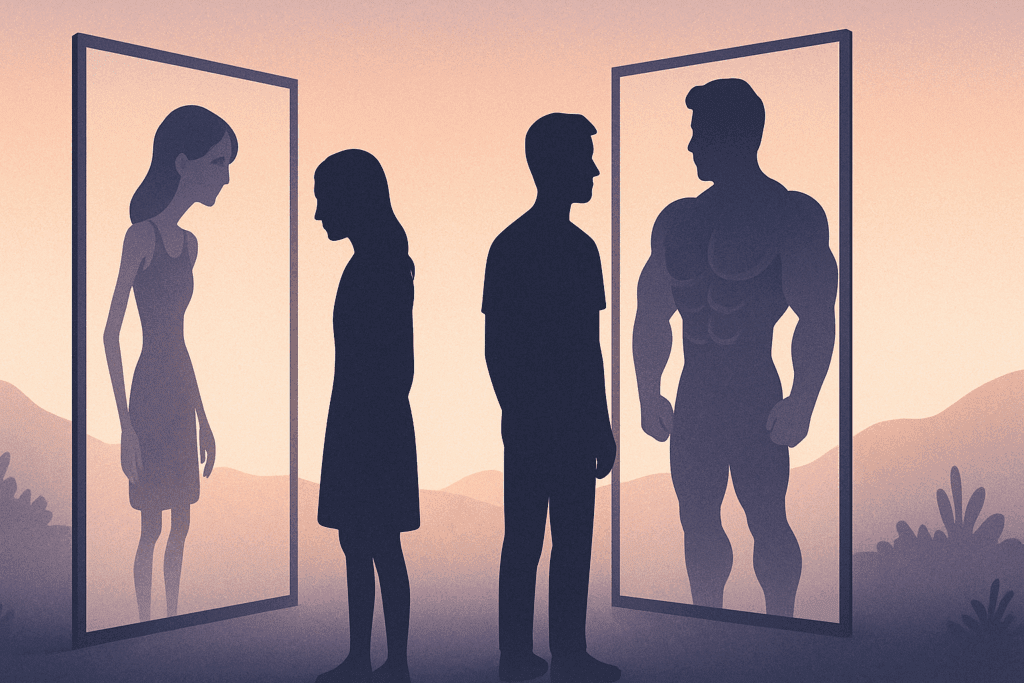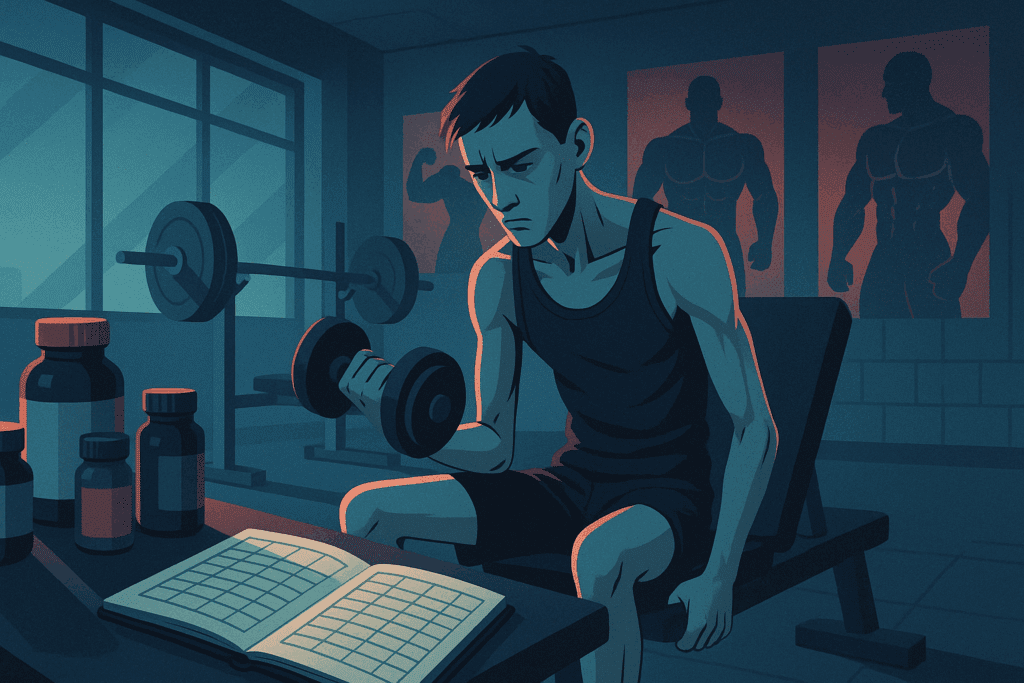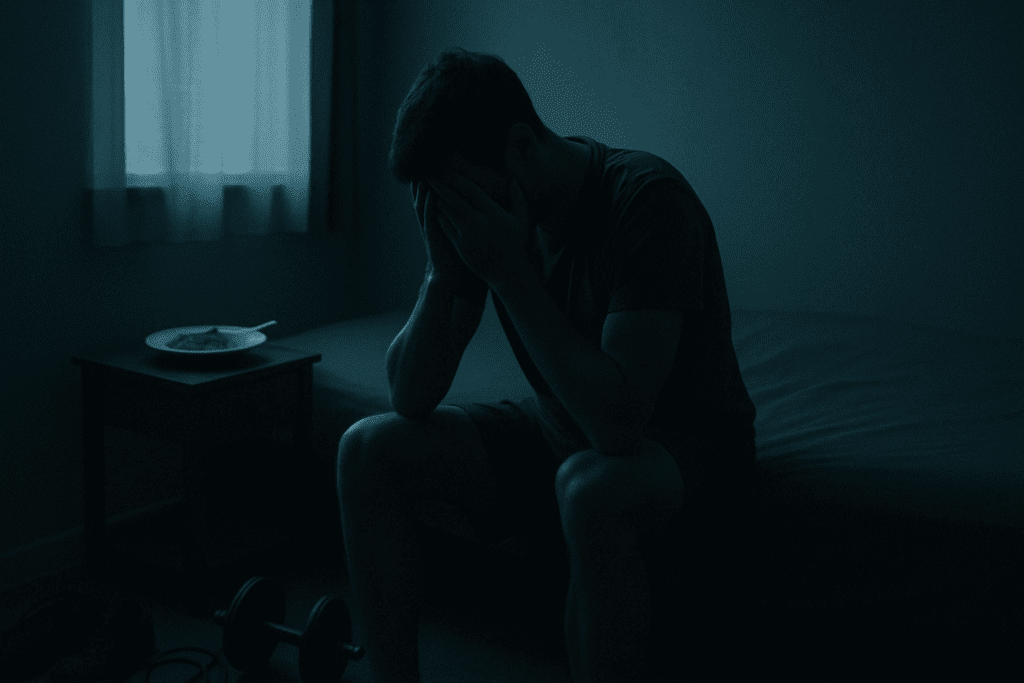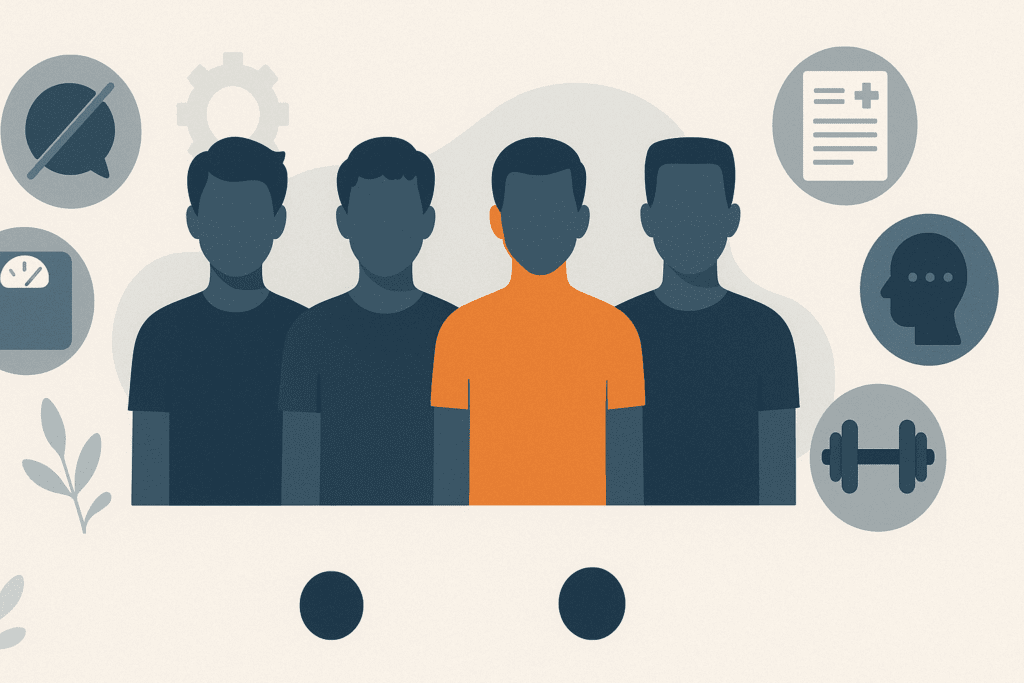The image of an anorexic person that dominates popular culture is often that of a young woman. This cultural stereotype has contributed to the widespread misunderstanding and underrecognition of eating disorders in men. As research evolves and public awareness deepens, it becomes increasingly evident that men are far from immune to these complex and dangerous conditions. Yet, males with anorexia nervosa often remain invisible in mainstream conversations, leading to delayed diagnoses, stigmatization, and inadequate support. Understanding how anorexia in guys manifests—and why it remains largely overlooked—is essential for addressing this growing mental health crisis.
You may also like: How to Stop Emotional Eating and Regain Control: Mindful Nutrition Strategies That Support a Healthier Lifestyle

Challenging the Stereotype: Can Men Have an Eating Disorder?
For decades, eating disorders were largely framed as issues affecting women and girls. Media portrayals and even medical research reinforced this bias, with most studies focusing almost exclusively on female populations. As a result, many still question, can men have an eating disorder? The answer is unequivocally yes. Men can and do suffer from anorexia, bulimia, binge eating disorder, and other forms of disordered eating, often with devastating consequences.
Male anorexia is frequently masked by behaviors that are culturally accepted or even encouraged in men, such as extreme dieting for fitness or excessive exercise to build muscle. This tendency complicates diagnosis and may prevent both individuals and clinicians from recognizing disordered eating patterns. An anorexic man might rationalize his restriction of food as part of a “clean eating” lifestyle or a bodybuilding regimen, making the underlying disorder harder to detect.

Understanding the Numbers: What Percentage of Anorexia and Bulimia Patients Are Male?
One of the most common misconceptions is that male eating disorders are rare. However, recent data tells a different story. Studies indicate that approximately 25% of individuals with anorexia or bulimia are male, though some researchers believe this figure could be higher due to underreporting. The stigma surrounding eating disorders in men often discourages them from seeking help or even recognizing their symptoms.
These statistics compel us to revisit outdated narratives and challenge entrenched biases in both the public and professional spheres. When asked, “What percentage of anorexia and bulimia patients are male?” the real answer reveals how widespread and underacknowledged the issue truly is. The lack of awareness has real consequences: delayed treatment can lead to more severe medical complications, longer recovery times, and increased risk of relapse in anorexic males.
How Anorexia Manifests Differently in Men
While there are many similarities in how anorexia affects men and women, several gender-specific differences can alter both the presentation and progression of the illness. Men with eating disorders are more likely to focus on body composition rather than weight alone. Whereas many women with anorexia strive to be thin, an anorexic male may be fixated on achieving a lean, muscular physique.
This distinction often results in a different set of behaviors. An anorexic guy might engage in obsessive calorie counting, intermittent fasting, or compulsive exercise routines under the guise of fitness. He may also misuse supplements or steroids to attain what he believes is the ideal male body. These behaviors, while clearly disordered, often go unchecked because they align with societal expectations of male discipline and strength. This makes it harder for both professionals and loved ones to identify the problem and intervene early.

The Psychological Toll on Men With Eating Disorders
Beyond the physical health risks associated with anorexia nervosa, the psychological burden borne by men with eating disorders is profound. Shame, guilt, and secrecy often define their experience. Because anorexia in guys contradicts societal norms around masculinity, many sufferers internalize the belief that their illness is a personal failure or sign of weakness.
This internal conflict can exacerbate mental health issues such as anxiety, depression, and low self-esteem. In some cases, it leads to substance abuse or self-harm. Males with anorexia nervosa often experience isolation due to their struggle being so misunderstood, which only intensifies the cycle of disorder. Lack of representation in awareness campaigns and treatment literature further marginalizes their experience and leaves them feeling invisible in the broader mental health conversation.
Why the Medical System Often Fails Anorexic Men
The healthcare system plays a pivotal role in perpetuating the invisibility of anorexic men. Despite advancements in research and treatment protocols, many medical professionals are still not adequately trained to recognize male eating disorders. Symptoms may be overlooked or misdiagnosed, especially when they are masked by athleticism or framed as commitment to a fitness routine.
Routine medical checkups often fail to identify disordered eating in men unless symptoms are explicitly mentioned, which they rarely are due to the associated stigma. Additionally, most screening tools were developed with female patients in mind, further compounding the problem. Even when diagnosed, anorexic males may face barriers to treatment, such as programs that are geared primarily toward women or group therapy environments where they feel out of place.
Cultural Factors That Contribute to Silence
Cultural expectations around masculinity significantly contribute to why male eating disorders are so often overlooked. From a young age, boys are taught to be stoic, tough, and emotionally reserved. Admitting to an eating disorder runs counter to these norms and is often perceived as a failure to conform to traditional ideals of masculinity.
This dynamic makes it especially difficult for men with eating disorders to seek support. An anorexic man might fear being judged, ridiculed, or dismissed entirely. He may downplay his symptoms or avoid disclosing them altogether, even to close friends or family. The lack of open dialogue about anorexia in guys contributes to its persistence and makes early intervention less likely.

The Role of Media and Body Image in Male Anorexia
In recent decades, the media has increasingly promoted a narrow and often unrealistic standard of male beauty. Chiseled abs, broad shoulders, and minimal body fat are held up as the ideal. This shift has led to a significant increase in body dissatisfaction among men, contributing to the rise of eating disorders.
For many men, the pressure to look a certain way is no less intense than it is for women, yet the conversation around body image remains disproportionately female-focused. An anorexic guy might feel disconnected from mainstream discussions about eating disorders, which often emphasize thinness rather than muscularity. Consequently, his symptoms might go unrecognized even by healthcare providers.
Social media amplifies these challenges, particularly among younger populations. Algorithms that favor fitness content can lead to the constant exposure of idealized male bodies, heightening insecurities and promoting harmful behaviors. Without adequate media literacy and mental health support, vulnerable individuals are more likely to develop disordered eating patterns.
Signs and Symptoms of Male Anorexia to Watch For
Identifying the signs of male anorexia requires a nuanced understanding of how the condition manifests in men. While weight loss is a common symptom, it may not be as pronounced or may be masked by muscularity. More subtle indicators include obsessive concern with body fat percentage, rigid eating habits, avoidance of social situations involving food, and excessive time spent at the gym.
Friends, family, and clinicians should also be alert to changes in mood, increased isolation, irritability, and a preoccupation with food or body image. These symptoms often emerge before any physical changes become noticeable and can serve as early warning signs. By recognizing these patterns early, loved ones can help an anorexic male access the care he needs before the disorder worsens.
Effective Treatment Approaches for Men With Eating Disorders
While the core principles of eating disorder treatment apply across genders, approaches must be tailored to address the unique challenges faced by men. Therapeutic modalities such as Cognitive Behavioral Therapy (CBT), Dialectical Behavior Therapy (DBT), and Family-Based Treatment (FBT) can be effective, especially when combined with nutrition counseling and medical monitoring.
However, these treatments should be delivered in environments that are inclusive and affirming for men. Gender-specific support groups, male-focused therapy tracks, and male clinicians with experience in eating disorders can improve outcomes significantly. Addressing the stigma around male anorexia directly within treatment settings can also empower patients to be more open and engaged in their recovery process.
Education and awareness are vital components of any successful intervention. When men understand that eating disorders are medical conditions—not moral failings or feminine issues—they are more likely to pursue treatment and adhere to recovery protocols. Family and peer support also play a critical role in reinforcing these messages and providing encouragement throughout the healing journey.

Preventing Male Eating Disorders Through Early Education and Intervention
Preventative strategies are essential for reducing the prevalence and severity of eating disorders in men. Education programs in schools, universities, and athletic organizations should include discussions on body image, mental health, and disordered eating that explicitly acknowledge male vulnerability. Curricula that challenge gender stereotypes and promote emotional expression can create a more supportive environment for young men.
Parents, coaches, and mentors must be equipped to recognize the early signs of disordered eating and to initiate compassionate conversations with boys and young men. Early intervention can prevent the development of full-blown anorexia and reduce the long-term physical and psychological impact of the disorder. By fostering open communication and reducing stigma, we can empower men to speak up about their struggles.
Public health campaigns also have a role to play. Messaging should be inclusive and feature diverse representations of people with eating disorders, including men of all backgrounds. By broadening the narrative, we can begin to dismantle the harmful myth that eating disorders are exclusively female issues.

Rewriting the Narrative: Creating a Culture That Supports Recovery for Anorexic Men
Changing how society views male eating disorders will require collective effort across healthcare, education, media, and community sectors. This begins with acknowledging that men are not only affected by eating disorders but also deserve the same level of attention, research, and compassion as women.
Efforts to include males with anorexia nervosa in research studies, training programs, and public awareness campaigns will help bridge the gap in understanding and care. Encouraging men to share their stories can also reduce stigma and build a sense of community among those in recovery. With greater visibility and validation, anorexic men will feel less isolated and more empowered to seek help.
Ultimately, recognizing anorexia in guys is not just a matter of accurate diagnosis—it is a matter of equity and justice. No one should be denied care or suffer in silence because of outdated gender norms or societal blind spots. By challenging these norms and expanding our collective understanding, we can create a world where all individuals with eating disorders are seen, heard, and supported.
Frequently Asked Questions: Understanding Male Anorexia and the Overlooked Crisis in Men’s Mental Health
1. Why is male anorexia often misdiagnosed or overlooked in clinical settings?
Despite growing awareness, male anorexia frequently goes undiagnosed due to gender biases embedded in diagnostic tools and clinical assumptions. Many assessments used to detect eating disorders were initially developed for women and don’t account for how anorexia presents in men. For example, males with anorexia nervosa may not exhibit extreme thinness but instead focus on muscle definition or reducing body fat to unhealthy levels. Clinicians may misinterpret these behaviors as fitness goals rather than signs of a deeper issue. As a result, an anorexic man may not receive appropriate intervention until the disorder has significantly progressed.
2. What unique psychological factors contribute to male eating disorders?
Male eating disorders are often tied to identity, control, and performance-related anxiety. Unlike the traditional thin-ideal narrative common in females, men may internalize the pressure to be lean, muscular, and dominant—traits culturally associated with masculinity. This can create a psychological environment where disordered eating becomes a coping mechanism. An anorexic male might obsess over his dietary intake and workout routine as a means to assert control in a chaotic life or to attain validation. These underlying psychological drivers are critical to address during treatment, but they often remain unspoken in standard clinical approaches.
3. Are certain professions or lifestyles more prone to anorexia in guys?
Yes, environments that emphasize physical appearance or performance—such as sports, modeling, acting, and military service—can significantly increase the risk of male anorexia. In these settings, men are often praised for extreme discipline, low body fat, or peak physical conditioning, which can mask early signs of an eating disorder. Over time, the pressure to maintain a certain physique may drive men with eating disorders deeper into restrictive or purging behaviors. This cultural reinforcement creates a dangerous feedback loop, making it harder for an anorexic guy to recognize his behavior as harmful. Prevention efforts in these industries remain limited but are gradually gaining attention.
4. How does the recovery process differ for men with eating disorders compared to women?
While many therapeutic principles apply to all genders, men with eating disorders often need treatment that explicitly validates their experiences. Group therapy environments predominantly composed of women can make men feel out of place or hesitant to share openly. Moreover, discussions about masculinity, identity, and societal expectations should be integrated into recovery plans for males with anorexia nervosa. Including male clinicians or mentors who have experienced recovery can also help normalize the process. Without these tailored supports, an anorexic man may disengage from treatment prematurely.
5. Can men have an eating disorder without showing significant weight loss?
Absolutely. One of the most dangerous misconceptions is that eating disorders must involve visible thinness. In reality, many men with eating disorders may appear to have average or even muscular bodies. A male anorexic might severely restrict calories or engage in compulsive exercise but still maintain a weight that doesn’t raise immediate concerns. Because of this, friends, family, and even healthcare professionals might overlook the severity of the issue. Understanding that anorexia in guys often manifests through behavior and obsession—not just appearance—is crucial for early identification and treatment.
6. What role does social media play in shaping male body image and eating behaviors?
Social media platforms increasingly expose men to narrow and often unattainable body ideals. Pages dedicated to fitness, bodybuilding, or “clean eating” can reinforce harmful standards and contribute to body dissatisfaction in males. Men with eating disorders often report compulsive comparison and heightened anxiety after browsing these platforms. In particular, younger generations are more vulnerable, as they’re still forming their self-concept and may internalize unrealistic images. For an anorexic guy, social media can act as both a trigger and a barrier to recovery, especially if he lacks access to body-positive content tailored to men.
7. How can parents and educators identify early signs of anorexia in adolescent boys?
Early signs of male anorexia in adolescents may include a sudden preoccupation with food quality, calorie counting, excessive exercise, and withdrawal from family meals or social events. Unlike girls, boys may mask these behaviors with claims of athletic ambition or fitness goals. Educators and parents should be cautious of rigid routines around eating and exercise that appear inflexible or punitive. Conversations about mens anorexia should begin early, using language that emphasizes emotional health, body neutrality, and personal wellbeing. Recognizing anorexia in guys at a young age can lead to faster recovery and fewer long-term health complications.
8. What support resources are available specifically for anorexic men?
While most eating disorder programs were initially developed for women, an increasing number now offer support specifically for men with eating disorders. Organizations such as the National Eating Disorders Association (NEDA) and the National Association for Males with Eating Disorders (NAMED) provide educational materials, therapy referrals, and community forums. Specialized inpatient and outpatient centers have also begun to create male-only tracks that acknowledge the unique challenges faced by anorexic men. These options can provide a more comfortable and validating environment for an anorexic male, improving both treatment engagement and long-term outcomes.
9. Why don’t more men talk about their struggles with anorexia?
The silence surrounding male anorexia is rooted in stigma and outdated gender norms. Many men fear that admitting to an eating disorder challenges their masculinity or will result in ridicule. The lack of public discourse about male eating disorders reinforces the belief that such struggles are shameful or rare. Even when males with anorexia nervosa want to seek help, they may not know where to begin or whom to trust. Creating spaces where men feel safe to share their experiences—whether in therapy, community groups, or media narratives—is essential for breaking this silence.
10. Has the percentage of males diagnosed with anorexia and bulimia increased over time?
Yes, data indicates that the percentage of males diagnosed with anorexia and bulimia has risen in recent years, though this may partly reflect improved recognition rather than an actual surge in cases. When exploring what percentage of anorexia and bulimia patients are male, research now suggests that roughly one in four individuals with these disorders is male. However, some experts argue that the true number could be higher due to underdiagnosis and stigma-related silence. This trend underscores the urgent need for more inclusive diagnostic criteria, broader public health messaging, and research specifically focused on male eating disorders. By acknowledging that male anorexia is neither rare nor new, we can begin to dismantle the barriers that have historically kept so many men in the shadows.
Conclusion: Recognizing the Hidden Crisis of Male Eating Disorders
The rise of male eating disorders signals an urgent need for change in how we perceive, diagnose, and treat these complex conditions. Males with anorexia nervosa, often overlooked and underserved, face unique challenges rooted in cultural expectations and systemic gaps in care. Asking, “Can men have an eating disorder?” is no longer sufficient. We must go further—acknowledging the prevalence of male anorexia, dismantling stigma, and ensuring equitable access to treatment for all.
Understanding what percentage of anorexia and bulimia patients are male reveals the depth of this hidden crisis and underscores the need for more inclusive health practices. By broadening our definitions and deepening our empathy, we can make meaningful strides toward a healthier, more supportive world for men with eating disorders. It’s time to bring anorexic men out of the shadows and into the light of recovery, where healing and hope are not limited by gender.
Was this article helpful? Don’t let it stop with you. Share it right now with someone who needs to see it—whether it’s a friend, a colleague, or your whole network. And if staying ahead on this topic matters to you, subscribe to this publication for the most up-to-date information. You’ll get the latest insights delivered straight to you—no searching, no missing out.
Further Reading:
Eating Disorders in Men Are Not Talked About Enough — and They’re on the Rise

